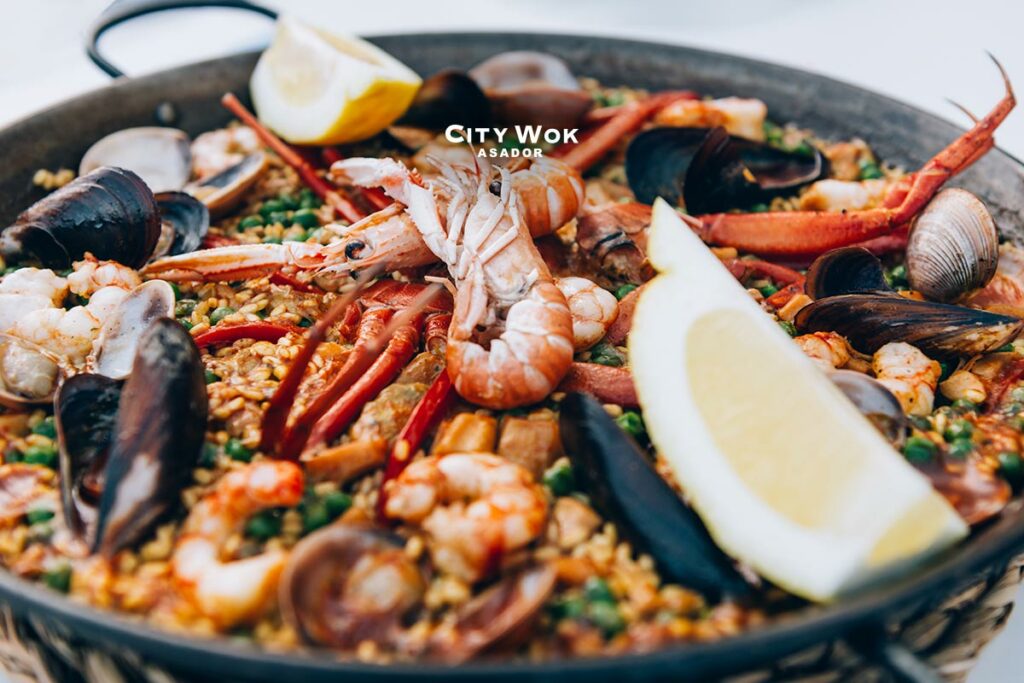¿Cómo hacer paella de marisco?

La paella de marisco, conocida también como “paella marinera”, es un plato típico de la gastronomía Valenciana. Junto con la paella tradicional, la paella de marisco, es un gran atractivo turístico para nuestro país.
Según la tradición, la paella nació en las regiones más rurales de la Comunidad Valenciana, como necesidad para contadinos y pastores de encontrar un plato sencillo y preparado con ingredientes autóctonos. La paella de marisco surgió gracias a la cercanía al mar Mediterráneo, que permitió a los pescadores locales empezar a utilizar los ingredientes frutos de la pesca para crear esta variante de la paella tradicional.
Características principales de la paella de marisco
La versión marinera de la paella se caracteriza por la presencia de diferentes pescados y mariscos que sustituyen la carne de pollo y conejo. Además, no contiene verduras y normalmente el agua se sustituye por el caldo de pescado.
Para cocinar una óptima paella de marisco el secreto reside en la preparación de un sabroso sofrito y caldo de pescado casero (o fumet), además de utilizar productos frescos y ricos de sabor.
En general, preparar una buena paella puede parecer simple, pero puede convertirse en una tarea complicada. Los errores más comunes que se cometen cuando se prepara una paella son:
- Elegir el tipo de arroz equivocado, el grano debe de ser redondo y corto.
- Las proporciones entre agua/caldo y arroz.
- Elegir ingredientes que no forman parte de la paella tradicional.
- No utilizar los utensilios de preparación tradicionales (paella de acero pulido/esmaltada/inoxidable y paellero de gas).
¿Quieres saber cómo preparar una paella de marisco perfecta para tus comidas domingueras? Ahora te lo vamos a explicar paso a paso.
Receta paso a paso
¡Empezamos! Primero, los ingredientes necesarios para preparar una paella de marisco son: arroz bomba, medio pimiento rojo, medio pimiento verde, perejil, un tomate maduro, una cebolla, un diente de ajo, aceite de oliva, sal, agua, hebras de azafrán, rape, mejillones, anillas de calamar, gambas, cigalas, ñoras y pimentón.
En cuanto a la elaboración, tras preparar todos los ingredientes, se empieza con sofreír cebolla y ajo bien picados, junto con los pimientos cortados en tiras. Cuando los vegetales estén pochos salamos y sofreímos en el mismo aceite los calamares o anillas de calamares previamente limpiados.
Seguimos con la preparación de la salsa de ñoras, para la cual empezamos rallando el tomate, que sofreímos junto con las ñoras, el azafrán y el pimentón dulce dentro de un cazo con aceite de oliva virgen extra (AOVE). Añadimos el arroz en diagonal en la paella y lo distribuimos uniformemente e integramos la salsa de ñoras.
Para el caldo, es posible comprarlo u obtenerlo de la cocción de pescado y mejillones. Hay que tener en cuenta que el volumen del caldo tiene que ser 3 veces el del arroz, sin embargo dependerá mucho del tamaño de la paella y del fuego. Si no tenemos suficiente caldo y el arroz está todavía seco, siempre podemos ir añadiendo agua.
Una vez juntado el caldo, el arroz y los demás ingredientes, el tiempo de cocción es de 18-20 minutos, pero dependerá sobre todo del tipo de arroz. Cuando queden pocos minutos de cocción se añade el marisco que tenemos reservado, mientras los mejillones adornarán la paella una vez hecha.
Tras apagar el fuego, hará falta dejar reposar la paella durante unos 5 minutos para que quede perfecta. ¡Ya tienes lista tu paella de marisco!, recuerda siempre verificar la cantidad de sal y el sabor mientras se está preparando.
Ven a Asador City Wok Granada y disfruta de una óptima paella de marisco en tu restaurante Wok buffet libre en Granada.